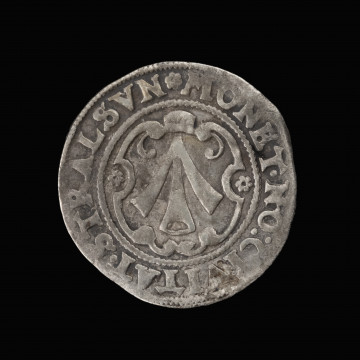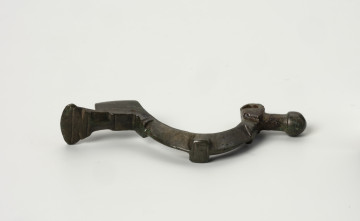
1/16 of a thaler
1647
National Museum in Szczecin
Part of the collection: Pomeranian coins
Stralsund had minting rights for more than 400 years (1325-1763), during which time it pursued its monetary policy. The privilege purchased from Duke Warcislaw IV of Wallachia in 1325 guaranteed the town full minting rights, including its type of issue, foot and images on stamps. The only restriction on the city was the ban on minting when the ducal mint was not in operation. Stralsund's separatism was further strengthened by the privilege of Emperor Ferdinand I (1559), which allowed the production of coins with imperial symbolism. The imperial eagle indicated the town's high status and its independence from the Pomeranian dukes. It is worth mentioning that the image of the griffin never appeared on the Stralsund coins. After the extinction of the House of Griffin and the division of West Pomerania in 1648, Stralsund came under Swedish rule. Not much changed in the coinage business, and coins were still made under the name and sign of the town. The exceptions were thalers and ducats, which had the eagle and the imperial title on the reverse. A new type of thaler, called the guilder or chanter thaler (worth 2/3 of a thaler, minted at a reduced mint rate), introduced in 1667, was coined in Stralsund under its stamps until the end (the last issue in 1707). Artistically, the Stralsund guilders are characterised by simple, even crude drawings. The design of the stamps was limited to two elements, namely, an arrow and a cross. The arrow on the obverse was the symbol of the town since its foundation in 1234. It can be seen on all coins minted in the modern period on the reverse of the guilders. A Greek cross, the symbolism of which usually referred to the four sides of the Christian world, with the vertical line depicting the action of grace, and the vertical line the penetrating action of a human, was placed. A fragment of the Psalm in the rim: IN NOMINE TUO SALVA NOS DEUS (God, save me, in Your name) (Ps 54:3-5) is a plea to God for rescue. The content of the stamp may have referred to the wars that King Charles XI waged between 1674 and 1679, which resulted in Sweden suffering significant territorial losses, mainly to Brandenburg, which occupied an entire part of Swedish West Pomerania. Peace negotiations succeeded in regaining most of the lost lands. The guilders are signed by the mint master Henryk Jan Hille, employed at this post also in Szczecin in 1666-1671. He put his initials HIH or the hook sign on the coins in both mints, and many Stralsund coins bear both signs in both mints.
Genowefa Horoszko
Other names
2/3 Reichstaler; Gulden
Author / creator
Dimensions
cały obiekt: height: 2.1 mm, diameter: 38.7 mm
Object type
coin
Technique
minting
Material
silver
Creation time / dating
Creation / finding place
Owner
National Museum in Szczecin
Identification number
Location / status

1647
National Museum in Szczecin

250 — 300
National Museum in Szczecin

1613
National Museum in Szczecin
DISCOVER this TOPIC
Museum of King Jan III's Palace at Wilanów
DISCOVER this PATH
Educational path